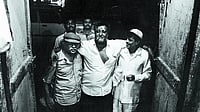
On the surface, Nagapattinam's NGO-inflated economy seems to be shining. Besides the surge in real estate, the cost of living too has shot up. "The sale of mineral water has increased by three times," says the cashier at Annapurna Hotel, a small tiffin centre. Hotel Tamizhagam, which came into existence this June and claims to offer three-star facilities with rooms priced between Rs 1,200 and Rs 2,000, has seen 70 per cent occupancy thanks to NGOs. "Besides an electronic gym, we offer ayurvedic massage for Rs 375, a facility most foreigners from NGOs use to destress," says hotel GM R. Ravichandran.
The scene is dismal even on the permanent housing front. "The same NGOs who built abysmal temporary shelters are building permanent homes," says M. Azhagesan of the Tsunami Legal Action Committee (TLAC) which has collected 1.6 lakh complaints (from 13 districts). In Madathukuppam village, NGO Gandeepam mixed sea-sand and seawater with the cement. Instead of a seven-foot pile foundation recommended by the government, it did a 1.5-foot brick foundation without granite. "The government does no checks. We drew the attention of the collector and got Gandeepam's work stopped," says Azhagesan.
In Singarathoppu, Cuddalore, the Evangelical Church of India (ECI) went ahead and built 70 one-room homes without informing the government. The district administration wised up to these poor, norm-defying in situ constructions only when the issue of evangelism cropped up apropos a 'tuition centre' run by the ECI. (Every religious outfit focuses on tuition centres for long-term harvests.) "The police has secured the disputed ECI structure," says district collector Bedi. The ECI has scooted. Sarada Siva, who lives in the ECI-built House No. 7, demands that we climb her terrace and look at the water that stagnates after every shower, which she hauls out in buckets. Each house has an embossed plaque: 'This House is a Gift from Providence Baptist Church, NC, usa, through ECI Relief Team'. "After dumping uninhabitable houses on us, the administration and other NGOs are ignoring us," says Kasambu, an old woman. "I wish the tsunami had killed me; at least my son would have got Rs 2 lakh compensation," she says—a refrain common among the aged forced to live in inhospitable conditions. Vehicles of Medecins Sans Frontieres (MSF), an NGO active in the Nagapattinam belt, have perhaps still not reached Singarathoppu to offer 'psycho-social care'.
If the ECI's was a case of unsolicited intervention, the Mata Amritanandamayi Math (MAM) is being actively encouraged as an ideal private partner in both Cuddalore and Nagapattinam. In Pudukuppam, Cuddalore, which witnessed 102 deaths, the task of permanent housing was allotted first to Oxfam India. But they did not deliver. "We were pushed into the task of temporary and permanent shelters. That's not our focus area. We made a token participation. Some partners on the field made a commitment, so we honoured it," says K. Gopalan of Oxfam, Chennai. In several places, including Pudukuppam, Oxfam's shoddy temporary shelters collapsed in a week.
Enter RSS outfit Seva Bharati, which introduced MAM to Pudukuppam panchayat president V. Chandran. MAM built 87 houses in record time by September. (Of the 46,000 permanent houses to be built in the first phase in the 13 districts, only 400 have been completed.) Every MAM house prominently bears the conch and discus symbols of the Math. The place has been renamed Amritanandamayi Nagar. There are several allegations against Chandran. Says resident C. Anbazhagan: "He has asked Rs 2,500 from each occupant of the MAM house." Chandran, who sold three acres of his land to the government at Rs 35,000 per acre, convinced 'beneficiaries' to part with this Rs 2,500 per head as compensation for the low price he got. He has also managed to get MAM to build 145 more houses for Pudukuppam. While officially only 137 houses are damaged, 232 will be coming up in their place. "This shows how these NGOs have so much to spend. The tsunami's created a lot of benamis," says Azhagesan.
Too many boats is another spoiler by the NGOs. Admits Vivekanandan: "There was an oversupply of fibre boats, mostly defective. The motor boats now are ten times the actual loss." In Sangolikuppam, the Claretians and the Family of India procured 25 small fibre boats (kannas) in place of the traditional catamarans. None of these boats is useful. "When we used them for inland fishing, they capsized. We collected our gear and swam to safety," says fisherman S. Pugazhendi. When contacted, Claretians said their responsibility ended with the supply of boats, made at Inniyan Fibres, Cuddalore. Inniyan manufactured 500 boats against various NGO orders, doing business of Rs 3 crore. "These boats are really light and structurally flawed," says Pugazhendi. The boat-makers, under pressure from NGOs keen to be the first to deliver, compromised on material. In Pudukuppam, the "spineless, unstable" boats gifted by the VHP and World Vision lie unused next to each other.
Says Vivekanandan: "NGOs seem to have preferred fibre boats because you can't really paint your names on catamarans." Pre-tsunami, one out-board motor (OBM) fibre boat was used by five fishermen. The fund-rich NGOs calculated the loss as one OBM boat per fisherman. Since most fishermen now have their own boats—however faulty—few want to work for others. While Bedi says the replacement of unwieldy, low-yielding catamarans is good "since fibre boats are safer for youngsters", one fallout of too many boats is lack of labour. "This results in parents employing their own children, forcing them to drop out of school," says an activist. It could also lead to over-fishing.
The tsunami has even spawned new NGOs. Nagapattinam's K.A. Seetalakshmi floated the Phoenix Federation in March 2005. Phoenix is yet to attract a serious inflow of funds. "We have heard that NGOs working in tsunami areas are being given fcras quickly. We hope it happens. We have 80(G) for now." Till February, people looked up to NGOs as succour-providers. Today, people see them as unscrupulous elements who thrive by peddling victimhood. "They come, pose with us, take pictures while handing us something, ensure media coverage and get funds. We are just being used," says Anbazhagan. Seetalakshmi's Phoenix office is wall-papered with photos of 'field work'. They even 'digitally documented' Outlook's visit. Bedi recalls other such camera-dependent outfits: "A TV actor from Mumbai, Ved Thapar, representing Ham Aawaz Trust, landed here on the fourth day after the tsunami and promised to buy boats, nets and engines for Mudisalodai village. He always went around with a handycam. One day he just vanished, and we could not reach him despite repeated efforts."
With the government a facilitator and the absence of civil society groups as watchdogs, the NGOs lord it over all that they survey. Even political parties are not asking questions. Instead, the cadre of CPI(M) affiliate Democratic Youth Federation of India have tied up with international NGOs such as MSF and the UK-based Every Child. "At least the government is an accountable entity. The NGOs aren't accountable to those they serve; they only have to give accounts to donors," says Azhagesan.
Eleven months after the tsunami, the NGOs are busy gathering data to "fill the gaps"—a favourite term with them. "Now every 'gap' is being projectised under pressure from donors," says TNSF's Babu. As K. Selvakumar of Pudukuppam sees it: "The only thing they can't give us back is lost lives." For all else, there's money.





















